Related Research Articles
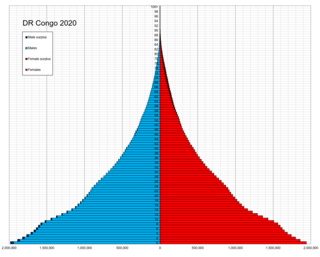
Demographic features of the population of the Democratic Republic of the Congo include ethnicity, education level, health, economic status, religious affiliations and other aspects of the population.

The Mbuti people, or Bambuti, are one of several indigenous pygmy groups in the Congo region of Africa. Their languages are Central Sudanic languages and Bantu languages.
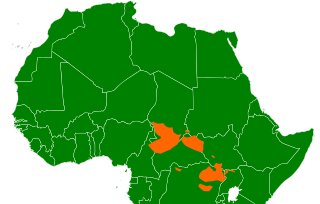
Central Sudanic is a family of about sixty languages that have been included in the proposed Nilo-Saharan language family. Central Sudanic languages are spoken in the Central African Republic, Chad, South Sudan, Uganda, Congo (DRC), Nigeria and Cameroon. They include the pygmy languages Efé and Asoa.
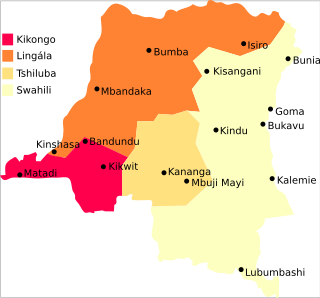
The Democratic Republic of the Congo is a multilingual country where an estimated total of 242 languages are spoken. Ethnologue lists 215 living languages. The official language, since the colonial period, is French, one of the languages of Belgium. Four other languages, three of them Bantu based, have the status of national language: Kikongo, Lingala, Swahili and Tshiluba.
Mangbutu is a Central Sudanic language of northeastern Congo. It, or its speakers, are also known as Mangu-Ngutu, Mombuttu, Wambutu. The 1,200 Andinai are separated from other Mangbutu speakers by Lese; they speak a distinct dialect, as do the Andali tribe.
Mangbetu, or Nemangbetu, is one of the most populous of the Central Sudanic languages. It is spoken by the Mangbetu people of northeastern Congo. It, or its speakers, are also known as Amangbetu, Kingbetu, Mambetto. The most populous dialect, and the one most widely understood, is called Medje. Others are Aberu (Nabulu), Makere, Malele, Popoi (Mapopoi). The most divergent is Lombi; Ethnologue treats it as a distinct language. About half of the population speaks Bangala, a trade language similar to Lingala, and in southern areas some speak Swahili.
Lese is a Central Sudanic language of northeastern Democratic Republic of the Congo, as well as a name for the people who speak this language. The Lese people, live in association with the Efé Pygmies and share their language, which is occasionally known as Lissi or Efe.

The official language of the Republic of Congo is French. Other languages are mainly Bantu languages, and the two national languages in the country are Kituba and Lingala, followed by Kongo languages, Téké languages, and more than forty other languages, including languages spoken by Pygmies, which are not Bantu languages.
Aka, also known as Yaka or Beka, is a Bantu language spoken in the Central African Republic and Republic of Congo, along the Ubangi River dividing the two countries.

The Kwasio language, also known as Ngumba / Mvumbo, Bujeba, and Gyele / Kola, is a language of Cameroon, spoken in the south along the coast and at the border with Equatorial Guinea by some 70,000 members of the Ngumba, Kwasio, Gyele and Mabi peoples. Many authors view Kwasio and the Gyele/Kola language as distinct. In the Ethnologue, the languages therefore receive different codes: Kwasio has the ISO 639-3 code nmg, while Gyele has the code gyi. The Kwasio, Ngumba, and Mabi are village farmers; the Gyele are nomadic Pygmy hunter-gatherers living in the rain forest.
Baka is a dialect cluster of Ubangian languages spoken by the Baka Pygmies of Cameroon and Gabon. The people are ethnically close related to the Aka, collectively known as the Mbenga (Bambenga).However, the languages are not related, apart from some vocabulary dealing with the forest economy, which suggests the Aka may have shifted to Bantu, with an estimated 15000 people have shifted.
Mangbetu may refer to:
Bila, or Forest Bira, is a Bantu language spoken in the Mambasa Territory of the Democratic Republic of Congo. It is also spoken by the Mbuti Pygmies who live in that area. Pygmy groups to the west include the Kango and Sua (Batchua). Other Mbuti speak Central Sudanic languages. The Kango and Sua speak distinct dialects, but not enough to impair mutual intelligibility with their farming Bila patrons.
The Asua or Asoa, also known as the Aka, are an Mbuti pygmy people of the Ituri forest. They speak a Central Sudanic language, Asuati, and are the only Pygmy group in the east to have their own language, though it is closely related to Mangbetu.
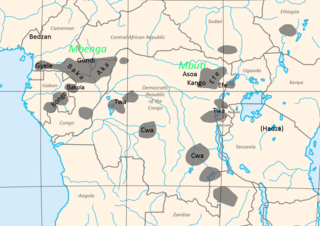
The term Congo Pygmies refers to "forest people" who have, or recently had, a hunter-gatherer economy and a simple, non-hierarchical societal structure based on bands, are of short stature, have a deep cultural and religious affinity with the Congo forest and live in a generally subservient relationship with agricultural "patrons", with which they trade forest products such as meat and honey for agricultural and iron products.
Mamvu is a Central Sudanic language of northeastern Congo. It is quite similar to Lese.
The Mangbetu–Asoa or Mangbetu languages of the Central Sudanic language family are a cluster of closely related languages spoken in the Democratic Republic of Congo.
The Mangbutu–Lese languages of the Central Sudanic language family, also known as Mangbutu–Efe or simply Mangbutu, are a cluster of closely related languages spoken in the Democratic Republic of Congo and Uganda. Moru–Madi languages are spoken to the northeast, and Mangbetu languages are spoken to the west.
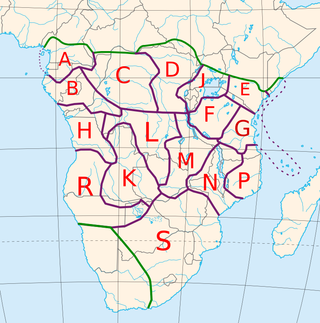
The Bantu peoples are an ethnolinguistic grouping of approximately 400 distinct native African ethnic groups who speak Bantu languages. The languages are native to 24 countries spread over a vast area from Central Africa to Southeast Africa and into Southern Africa. There are several hundred Bantu languages. Depending on the definition of "language" or "dialect", it is estimated that there are between 440 and 680 distinct languages. The total number of speakers is roughly 1 billion by 2023. About 120 million speakers (2024), divided into some 200 ethnic or tribal groups, are found in the Democratic Republic of the Congo alone.
Nangazizi is a settlement in the province of Haut-Uélé in the Democratic Republic of the Congo.
References
- ↑ Asoa at Ethnologue (18th ed., 2015) (subscription required)
- ↑ Demolin, Didier. 1992. Le Mangbetu: etude phonétique et phonologique, 2 vols. Brussels: Faculté de Philosophie et Lettres, Université libre de Bruxelles dissertation.